When my mother came to the UK in the early 60’s (via Turkey and India, but she was in fact German) she was dismayed at the bread available at the time. She was used to an array of rye, wheat, full grain, sourdough, in fact hundreds of different types of bread that she had grown up with. But in Tunbridge Wells, where we lived, the only bread available was a white loaf and the variation was sliced or whole.
So my mother did what she so often did when the need arose, she learned how to do it herself. I don’t think she had ever made bread before, she was brought up with a cook, had servants in India and actually had little interest in cooking, it was a kneads must situation (‘scuse pun). Consequently the recipe she used to make the bread was very simple and is what I still use today. Every time I make it there’s a little variation in how it turns out depending on how long I’ve let it rise, what flour I used, the heat of the oven, if people were watching me, etc. I am not a very exacting cook, weighing only the flour and the yeast, adding the water by instinct, but I quite like the way it always comes out slightly different. As in life I enjoy the unexpected.
Bread is actually very easy to make, a lot of people are daunted by it, but as long as you are around for the various steps. it is quite simple.
I use a mixture of wholemeal and stone-ground white flour, half and half. My mother used to make two loaves at a time as she was feeding a family of four kids and one Labrador, who had a slice in the morning crumbled up with milk and water. But I tend to just make one loaf, as I don’t have as many mouths to feed and I like it fresh.
I put a well in the middle of 500kg of flour and add a teaspoon (5ml) of dried yeast, 1/2 a teaspoon of brown sugar and about 150 cl of tepid water. Then I let it sit for about 10 minutes until the yeast bubbles up in the water.
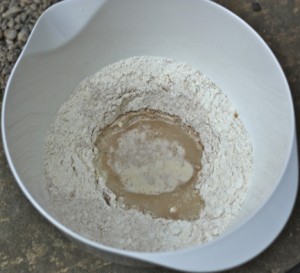
I then add 1 tbs of salt. This may sound excessive and you can reduce the salt if you like. Commercial bread manufacturers maintain that home made bread uses too much salt and is therefore less healthy. I think if you weigh up the pros and cons of simple, non processed ingredients against refined processed flour etc. home made bread is still going to be much better for you. If you’re worried about your salt intake use it sparingly on your veg. and keep off the crisps (chips) and other processed foods.

I then combine the flour and salt with the water and yeast, gradually adding 200ml of tepid water and mixing it together with my hands.
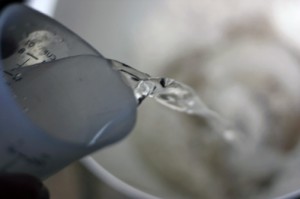
The dough should not be too wet so that it’s sticky but moist enough to hold together. Most people then take the dough out of the bowl and knead it on a floured board, but I do it in the bowl, less washing up and that’s how my mother did it.

Again people will tell you how to knead the dough, just do it how it feels right to you, you’ll soon get your own rhythm, but don’t be too gentle, get your whole body weight behind it. This is the only slightly hard part of the process, but it is also when the magic happens, when all the ingredients come together and the dough takes on its own shape.
I knead the dough until it becomes elastic and comes away from the bowl and I can easily pull it from my fingers.

Then I cover it with a cloth and leave somewhere warm to rise, my mother used to put it over the boiler, but I just leave it on the kitchen table as I don’t have a warm cupboard or heater.

After about an hour, less if its been in a warm spot, when the dough has doubled in size, I give it another bit of a knead, to knock the air out of it, and put it in a lightly oiled baking tin, in fact the very same baking tin my mother used for 40 odd years. Then I leave it to rest for about 1/2 an hour to an hour to rise again. I often sprinkle it at this stage with sesame seeds.

I then pre-heat the oven to its hottest setting and cook the bread for 30 minutes. This is the only way I differ from my mother’s methods, she would put it in a hot oven, for 1/2 an hour and then on a lower setting for an hour. I guess at some point we have to move on as children and do our own thing.
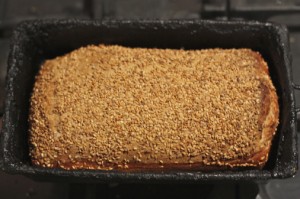
If you’re not sure if its been in the oven long enough, knock the bottom of the tin, it should sound hollow.
Leave in the tin to cool for 30 mins and then turn out onto a wire rack.
Oh and whenever friends came round, they would devour my mother’s bread, preferably when it was still warm. I was recently asked for the recipe from one of these friends after all these years. Here it is.
- Bread
- 500kg wholemeal flour
- 1 tsp dried yeast
- 1/2 tsp brown sugar
- 1 tbs salt
- 300ml warm water, blood temperature
- Oil for the tin
Put the flour in a bowl. Make a well in the middle, fill with 150cl warm water and sprinkle with 1 tsp yeast and 1/2 tsp sugar. Leave for 10 minutes until bubbles form on the surface.
Fold the flour into the water and yeast and gradually mix with your hands. Then add a tbs salt and slowly incorporate 200cl of water. The dough should not be sticky and should hold together
When all is mixed together, knead for a few minutes until the dough feels elastic and comes away from the bowl and your fingers.
Cover with a cloth or cling-film and leave somewhere warm. After about an hour or when it has doubled in size, knead some more to take out the air. Then put into a lightly oiled bread tin and leave for 1/2 an hour, or until it has risen again in the tin.
Meanwhile pre-heat the oven to the hottest temperature and when the dough is ready, bake for 1/2 an hour. If you are unsure whether it is cooked or not, knock the bottom of the tin. It should sound hollow and the bread should have come away from the sides of the tin. Leave in the tin to cool for 30 mins then take out and leave to cool further on a wire rack.
Here is a loaf I made earlier, in fact two months earlier, kindly photographed for Provence Calling by Patrick Cadell
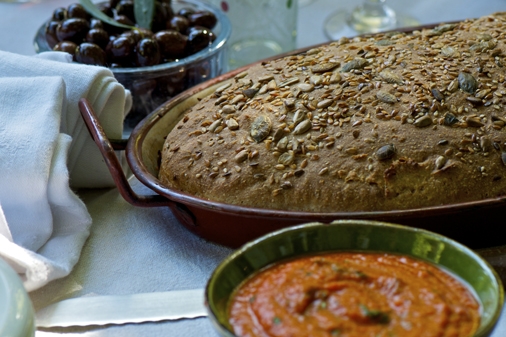
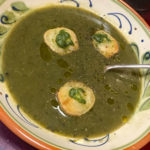















There is really nothing better then fresh home made bread.
Theres nothing better then Ange’s fresh bread…. mmmm i miss waking up to the smell coming up the stairs. Its so delicious!!
Perhaps this will get me back into making bread again the way our mum did it. I can almost smell it off the discription you’ve given it here. Great photos.
As a scientist I prefer to measure the temperature: Voll über Schwein. I like homemade bread *gg**
I assume the 150 cl of tepid water referred to in your bread recipe is actually 150 ml?
“I put a well in the middle of 500kg of flour and add a teaspoon (5ml) of dried yeast, 1/2 a teaspoon of brown sugar and about 150 cl of tepid water.”
What a lovely post. I want to start making my own bread, and this is the push I need
Thanks so much for commenting and glad I have inspired you!